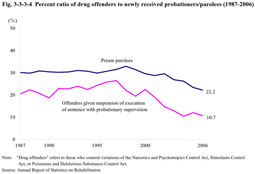| Previous Next Index Image Index Year Selection | |
|
|
4 Probation / parole supervision
Fig. 3-3-3-4 shows the percent ratio of drug offenders (those who commit violations of the Narcotics and Psychotropics Control Act, Stimulants Control Act, or Poisonous and Deleterious Substances Control Act) to the offenders given suspension of execution of sentence with probationary supervision and to the prison parolees newly received over the last 20 years.
The ratio of prison parolees has been on a declining trend since 1999, and that to offenders given suspension of execution of sentence with probationary supervision has been on the same trend since 2001. In the categorized treatment system (see Part 2, Chapter 5, Section 2, 2 (2)), drug offenders are classified into “stimulant drug offenders” and “abusers of thinners, etc.,” and efforts for effective treatments are made to deal with individual problems. Also group treatments, which take note of common characteristics among the same kind of offenders, lectures for guardians and guarantors, and others are conducted. For prison parolees and offenders given suspension of execution of sentence with probationary supervision for stimulant drug offenses, treatment utilizing simplified urine tests based upon their voluntary willingness started in April 2004. In 2006, 7,009 tests were conducted for 3,054 prison parolees and offenders given suspension of execution of sentence with probationary supervision (Source: The Rehabilitation Bureau, Ministry of Justice). Fig. 3-3-3-4 Percent ratio of drug offenders to newly received probationers/parolees (1987-2006) |
